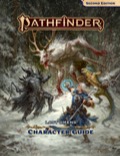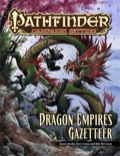Sign in to create or edit a product review. 
Pathfinder Lost Omens: Character GuidePaizo Inc.Add Hardcover $34.99 Add PDF $29.99 Non-Mint Unavailable A return to quality with a questionable price tag.When the Inner Sea World Guide hit a decade ago, I was blown away. More than the elegant refinements made to the 3.5 system, it was the richly detailed and innovative setting that cemented my loyalty to Pathfinder. Over the years, that began to change. I started seeing a lot of supplemental books that had a lot of space allocated to either pitching other products (multiple sidebars that essentially said "if you want to make full use of these rules, check out these other books we make.") and consolidating materials that had already appeared in other sourcebooks. Until 2nd ed hit, I think it had been two years since I purchased a Pathfinder product. They were getting sloppy and they were getting lazy. This book, and the Lost Omens World Guide, was like going back a decade in many respects. It's not wanting in either crunch or fluff. In addition to new options for all existing ancestries, it goes into new, previously unexplored detail on non-human ethnicities (and a few new human ones), something I've wanted to see approximately forever. The three new ancestries get a similar treatment, though they are, being new, a little heavier on the crunch side. While I'm a little bummed that we still don't have rules for playable Aasimars and Tieflings, it seems Paizo wants to forge its own path in this edition, and that includes branching out with their first non-core PC races. Lizardfolk seem cool, and with Oparak being added to the setting hobgoblins are a natural choice, though the leshy really come out of left field. Ancestries comprise about half of the book, and the other half is organizations and factions. Though the Firebrands seem like uninspired ("we're a loosely organized and generic chaotic good faction, but we also dress fashionably so as to not be TOO generic!"), the rest are fantastic. We get expanded or new archtypes for all of them, as well as more feat support, and that's on top of histories, information on how they've evolved since 1st ed, and (very) brief writeups of major NPCs. What impresses me most is that the book is all about ancestries and factions, but I didn't feel like it was stretched or padded. All 138 pages are worth reading. But are all 138 pages worth paying for? If you like hardcover, it's probably just a little overpriced. If you prefer PDFs, though, it's almost insulting. At 10 bucks for its PDF, the Inner Sea World Guide was a steal. I happily would have paid twice that. And though this book's overall quality is similar to the ISWG, it's less than half the length for more than twice the price. Even if we account for inflation, this kind of increase is about 15 years ahead of schedule. Overall, the books has great fluff and provides more options that are a bit inconsistent in their viability. Definitely add this to your wishlist, but unless you have a lot of disposable income, wait for a sale. 
Pathfinder Roleplaying Game: Bestiary 5 (OGL)Paizo Inc.
Add
Hardcover
Add PDF $19.99 Non-Mint Unavailable What we've come to expect from late-instalment bestiariesWhen the Pathfinder Core Rulebook first hit the shelves, I fell head over heels in love with it. As it's grown, and become more prominent in RPG spotlight, I've developed a love-hate relationship with it, and this book does nothing to change that. Let's start with the good. The monsters presented have a solid mix of CRs - in particular I think some of it's low-CR creatures offer some spice to the opposition for fledgling adventurers. There are some mythic monsters here too, most of them on the higher end of the CR spectrum, so GMs will have a few new challenges to toss at the more seasoned characters as well. This book also adds a handful of outsiders to those that haven't received a lot of love, like Divs, Aeons, and Demodands, though several of these are reprints from APs. I don't buy every AP, though, so I'm not complaining. There are a couple of real gems in here, like the Empyrean Angels or the supremely cool Sahkil - a variety of rogue psychopomps. And now the bad. It's really just one thing, but, for me, it's pretty glaring, and exactly why my love of Pathfinder has been slowly but steadily dwindling. Despite the few gems, most of the new monsters just come off as really uninspired. Paizo continues pulling creatures out of myth and pop culture, but we're seeing some really superficial interpretations of those myths, and we're starting to rip monsters straight out of recent films like Prometheus. I understand the appeal of some of these creatures, but this one was so similar to its source material that it just felt lazy and unoriginal. By and large, this book is filled with creatures that don't seem to bring anything new to the table, and in some cases fill roles within a game that are entirely redundant with monsters that we've already got. Looking through the monsters, I just found myself wondering if there was really a need for this book. It felt like someone said "We have a new bestiary coming out, we need to come up with monsters to fill it with," as opposed to Paizo's books of five years prior, which felt more like "We've still got a ton of cool monsters! We need a book for them!" All told, the book has some value, but definitely not a $45 one. The good stuff is probably good enough to warrant getting the pdf, but I wouldn't get the hardback 
Pathfinder Campaign Setting: Dragon Empires Gazetteer (PFRPG)Paizo Inc.
Add
Print Edition
Add PDF $15.99 Non-Mint Unavailable Brilliant but briefDragon Empires is a highly flavorful product, rich with a "Paizofied" spin on a high-fantasy Asian setting. It's clear that the same brilliant design philosophy that was applied to Avistan went into Tian-Xia, and the result is a shining fusion of various east-Asian settings that pulls from both real-world myth and culture and from stylized fantasy tropes. What I appreciate more than anything is the lack of distinct analogues. Despite clear inspirations, there is no country that is "just Japan." There is no China in the Dragon Empires, but rather various elements have been picked out from various cultures, then combined in some places and redistributed in others. The result is a highly organic setting that leaves you yearning for more, and that's also it's greatest problem. I understand the limitations of manpower, and that Paizo needs to keep its other products in mind, but this book really warranted more than 64 pages. Tian-Xia seems to be at least twice the size of Avistan, but due to each nation getting a single page, it feels like less than half of that. Each country in the Dragon Empires has a fantastic basis, but they're barely explored, and the result is that they feel more like small states of a larger nation that contribute small regional quirks, as opposed to the fully developed cultures we saw in the Inner Sea World Guide. This is a setting that's screaming for more detail. My other beef with the product is the five new PC races. I know a lot of people are excited about them, and they certainly have their place, but I think the focus should have been on how the existing races (elves, dwarves, gnomes and whatnot) can be culturally and mechanically adapted to this new region of the world. To much exoticism in these new races makes Tian-Xia feel a little bit like a nation of monsters. The new guys, I think, should have filled a role similar to aasimars and tielfing. That is, they exist, they have a presence, and they're suitable options, but they take a backseat to the more established guys. All in all, the Dragon Empires Gazetteer is very well-done given how much space was allotted to it. It's intriguing and certainly grabs one's interest, but it left me far from satisfied. |
|



